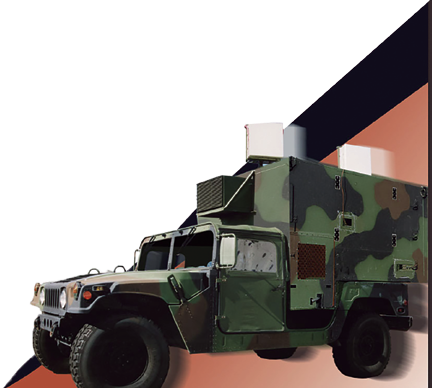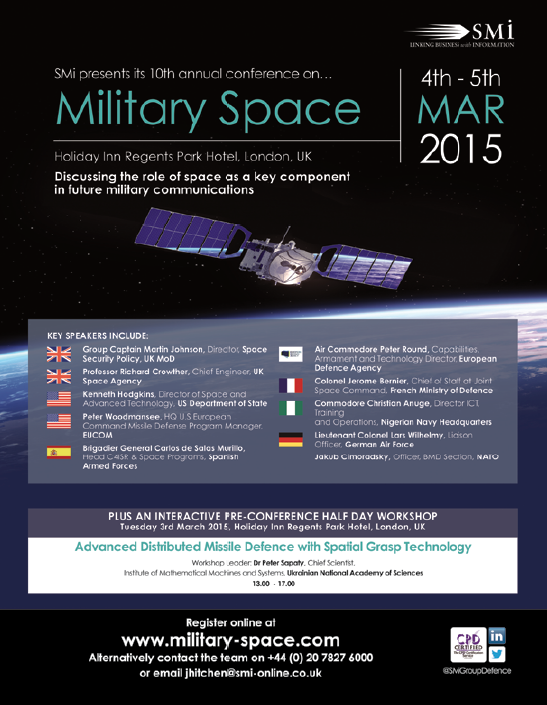Situational awareness is essential for warfighters involved in combat operations and critical for those responsible with force protection.

Unfortunately, situational awareness in convoys can come at a cost for commanders in-the-field who find vital communications marked as targets due to the telltale signs of a satellite antenna. This dilemma is one the U.S. Army is looking to change with a contract recently awarded to Harris Corporation to develop a revolutionary new satellite communication system.
Traditionally, tactical satellite communications (SATCOM) antennas have been housed in a single large antenna dome on top of a combat vehicle. The antenna must be mounted high on the hull and clear of anything that might block its line-of-sight toward the sky. Furthermore, the antenna dome cannot interfere with the vehicle’s crucial weapons systems. The awkward placement of an antenna dome inherently makes the antenna vulnerable to enemy fire—and also marks the vehicle as a command and control platform.
Imagine, if you will, being a battalion commander of an armored unit that operates a mixed fleet of M1A2 Abrams main battle tanks and M2A3 Bradley infantry fighting vehicles. As a battalion commander, your communications capability provides the vision needed to lead the frontline battle.
Thus, at least one armored vehicle under your command should be equipped with a SATCOM terminal to provide that long distance vision. A traditional satellite antenna for that system instantly sets your Bradley fighting vehicle apart from the others in the unit. The enemy can instantly recognize your machine as a communications vehicle and focus their attacks on you leaving your troops leaderless—if the worst should happen.
However, Harris’ Distributed Aperture Architectures could change all of the that. Working under a new contract from the Army’s Communications-Electronics Research, Development and Engineering Center (CERDEC), Harris will develop a SATCOM system that would lower the profile of a communications vehicle to where such would be difficult to distinguish from a regular armored combat vehicle.
Called the distributed embedded satellite communications on-the-move terminal, the program aims to develop an entirely new kind of antenna system. Instead of a single large dome, the distributed aperture architecture would incorporate four low profile, electronically steered, phased array antennas.
These four antennas would work together to coherently combine beams and potentially outperform traditional satellite antennas. While distributed aperture receivers are not new, this terminal will represent the first time anyone has ever attempted to use the technology for an on-the-move satellite terminal. The end result will be revolutionary.
The four distributed phased array antennas, which are small and have little resemblance to a traditional device, would be distributed around the hull of the vehicle, which for CERDEC’s initial demonstration purposes will be a Bradley fighting vehicle.
From an outside observer’s perspective, it would be difficult to distinguish that fully equipped command vehicle from a regular M2A3 Bradley, and that is the point—the antennas will blend in with the the other vehicles in the battalion. There is no way for the enemy to tell the difference unless they know exactly what minute details to look for.

There are other advantages as well. Traditional satellite dome antennas require a large hole to be cut into a combat vehicle’s armor, which weakens overall protection and introduces a point of vulnerability.
A distributed aperture system does not need huge holes to be cut into a vehicle’s armor. In fact, it might be possible to use existing hull penetrations to mount the smaller distributed apertures.
As the overall system is more conformal than traditional satellite communications antennas, integration is simple, even on smaller vehicles. Everything from a 70-ton Abrams main battle tank, to a Bradley, to a Striker, to a diminutive Humvee, all could be equipped with this system. Once the system is proven to be successful, the technology will inevitably spread to the Marine Corps, the Navy and, possibly, the Air Force. This is because it would be possible to mount a distributed aperture system onto the conformal surfaces on an aircraft, such as a helicopter.

There are also other advantages in battle for a distributed aperture antenna system. While a single dome antenna’s signal can be interrupted if something blocks its line-of-sight, a distributed aperture system has four or more separate antennas. Even if several of those are blocked, it can still transmit with the remaining antennas. In fact, the system could keep transmitting even if multiple antennas were damaged or destroyed. Furthermore, elements of the collective array could form multiple beams, or adaptively null out enemy jammers. Thus, the system adds a level of resiliency that will help troops engaged in combat where battle damage is inevitable.
This is just the prototype. Harris’ future versions of the system will be scalable and will be able to add or subtract antennas as needed for the specific application. Nor does the Army have to limit itself to phased array antennas; one day it could opt for cheaper hardware, or even more capable active electronically scanned systems, if it so chooses. The possibilities are endless, and Harris is laying the foundation for the future.
For the Army—and more importantly for the soldiers whose lives depend on reliable equipment—the service’s small initial investment in a distributed aperture satellite antenna promises huge dividends. Once CERDEC and Harris demonstrate the true potential of this new technology, the door will be open for full-scale development and integration into the Army’s future communications networks. This is a revolutionary capability, and only time will tell what the possibilities might be. The sky’s the limit.

Harris COTM (Communications-On-The-Move) infosite: http://govcomm.harris.com/solutions/products/000020.asp
Edward J. (Ed) Zoiss is vice president and general manager of the Defense business unit for Harris Government Communications Systems (GCS). GCS develops, produces, integrates, and supports advanced communications and information systems that solve the mission critical challenges of its defense, national intelligence, and civil agency customers worldwide. The Defense business unit serves domestic and international customers with critical military interoperable communication products, as well as Intelligence, Surveillance, and Reconnaissance (ISR) solutions that protect national security and aid public safety agencies.



